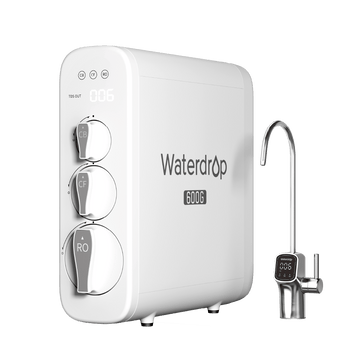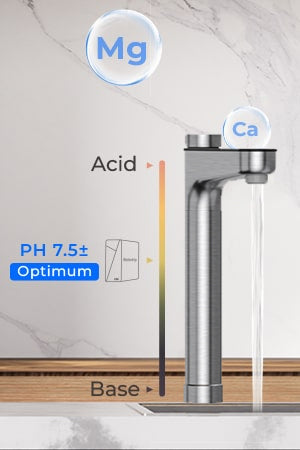Agus tú ag brabhsáil an aisle uisce i do Tesco, Carrefour, nó REWE áitiúil, is dócha gur tháinig tú trasna ar lipéid ar nós “uisce íonaithe” agus “uisce driogtha”. Ar an gcéad amharc, d’fhéadfadh siad a bheith inmhalartaithe. Tar éis an tsaoil, geallann an dá cheann íonacht agus glaineacht ard. Ach an bhfuil siad i ndáiríre mar a chéile?
I gcás tomhaltóirí ar fud na hEorpa, áit a bhfuil caighdeáin cháilíochta uisce ard agus roghanna atá feasach ar an gcomhshaol ag éirí níos coitianta, tá tuiscint níos tábhachtaí ná riamh ar an difríocht idir uisce íonaithe agus uisce driogtha. Sa treoir seo, déanaimid miondealú ar gach rud — an eolaíocht, na húsáidí, an tionchar sláinte — i dteanga shimplí.
Cad is Uisce Íonaithe ann?
Is uisce é uisce íonaithe atá scagtha nó próiseáilte chun eisíontais, truailleáin agus ceimiceáin dhíobhálacha a bhaint. Áirítear leis seo substaintí cosúil le clóirín, baictéir, miotail throma agus solaid thuaslagtha.
Chun an sainmhíniú ar “íonaithe” faoi chaighdeáin AE agus idirnáisiúnta a chomhlíonadh, ní mór nach mó ná 10 gcuid in aghaidh an mhilliúin () a bheith san uisce.
ppm ) de sholaid thuaslagtha. Is é sin le rá, tá sé thar a bheith glan — ach is féidir leis an modh íonúcháin a bheith éagsúil.
Modhanna Íonúcháin Choitianta
- Osmóis droim ar ais (RO): Scagann scannán cáithníní, baictéir agus mianraí amach.
- Dí-ianú (DI): Úsáideann sé roisíní malairte ian chun iain (cosúil le cailciam nó maignéisiam) a bhaint.
- Scagadh Carbóin: Baintear clóirín, boladh agus comhdhúile orgánacha.
- Cóireáil UV: Maraíonn sé baictéir agus víris ag baint úsáide as solas ultraivialait.
Is féidir gach ceann de na teicnící seo a úsáid ina n-aonar nó i gcomhar le chéile. Is í cáilíocht an uisce deiridh atá tábhachtach, ní gá gur conas a baineadh amach í.
Cad is Uisce Driogtha ann?
Is cineál uisce íonaithe é uisce driogtha - ach téann sé trí phróiseas ar leith ar a dtugtar driogadh.
Seo mar a oibríonn sé:
1. Déantar uisce a fhiuchadh ina ghal.
2. Éiríonn an gal agus fágann sé eisíontais ina dhiaidh.
3. Ansin fuaraítear an gal agus comhdhlúthaítear é ar ais ina uisce leachtach.
Baintear leis an modh seo:
- Mianraí (cosúil le sóidiam agus cailciam)
- Baictéir agus víris
- Miotail throma
- Go leor cineálacha comhdhúile orgánacha
Tá sé in úsáid le blianta fada i saotharlanna, i suíomhanna leighis, agus i dtionscail a bhfuil uisce thar a bheith glan ag teastáil uathu.
Uisce Driogtha = Uisce Íonaithe?
Ní go díreach.
Déantar gach uisce driogtha a íonú, ach ní dhéantar gach uisce íonaithe a dhriogadh. Níl sa driogadh ach modh amháin íonúcháin - agus uaireanta ní hé an modh is praiticiúla ná is inbhuanaithe é, go háirithe ar scála mór san Eoraip.
Príomhdhifríochtaí idir Uisce Íonaithe agus Uisce Driogtha
Cuirimis iad taobh le taobh le go mbeidh sé níos éasca:
Cé acu is Fearr le hÓl san Eoraip?
Blas agus Ábhar Mianraí
Tá mianraí sláintiúla cosúil le cailciam agus maignéisiam i bhformhór uisce sconna na hEorpa — agus is maith le go leor daoine blas uisce atá saibhir i mianraí. Ar an láimh eile, is féidir le huisce driogtha blas réidh nó fiú aigéadach a bheith air.
Is minic a choinníonn uisce íonaithe (go háirithe ó osmosis droim ar ais) blas níos fearr agus féadfaidh sé méideanna beaga mianraí a choinneáil, rud a fhágann go bhfuil sé níos oiriúnaí le haghaidh hiodráitithe laethúil.
Breithnithe Sláinte
- Tá easpa mianraí in uisce driogtha, rud a d’fhéadfadh a bheith ina fhadhb má’s é an t-aon fhoinse uisce atá agat san fhadtéarma. Údarás Sábháilteachta Bia na hEorpa ( EFSA ) molann iontógáil mianraí ó bhia nó uisce a choinneáil.
- Baintear truailleáin cosúil le clóirín nó luaidhe le huisce íonaithe fós, agus b'fhéidir go gcoinnítear mianraí rian riachtanacha.
Mura bhfuil riachtanas leighis agat,
uisce íonaithe is rogha níos cothroime é le haghaidh óil rialta.
Tionchar Comhshaoil san Eoraip
Tomhaltas Fuinnimh
Úsáideann driogadh go leor leictreachais, rud a fhágann go bhfuil sé níos lú neamhdhíobhálach don chomhshaol i gcomparáid le hosmosis droim ar ais nó scagachán carbóin. Is ábhar imní atá ag fás é seo i réigiúin atá feasach ar fhuinneamh ar nós na Scandinavia agus na hÍsiltíre.
Dramhaíl Uisce Buidéalaithe
Cé go ndíoltar uisce íonaithe agus driogtha araon i mbuidéil, tá go leor tomhaltóirí Eorpacha ag casadh air
córais scagacháin uisce tí chun úsáid plaisteach a laghdú. Tá aonaid RO nó scagairí sconnaí ar fáil go forleathan ar fud na hEorpa agus tá siad níos inbhuanaithe san fhadtréimhse.
Miotais agus Míthuiscintí Coitianta
Miotas 1: Tá gach uisce buidéalaithe mar an gcéanna
Bréagach. Tá comhdhéanamh agus cuspóirí difriúla ag uisce mianraí, uisce íonaithe agus uisce driogtha. Léigh an lipéad i gcónaí - go háirithe i dtíortha cosúil leis an bhFrainc, an Ghearmáin nó an Iodáil, áit a bhfuil cineálacha uisce buidéalaithe an-difriúil.
Miotas 2: Is é Uisce Driogtha an Rogha is Sláintiúla
Ní go hiomlán. Cé go bhfuil sé thar a bheith glan, mar gheall ar easpa mianraí, níl sé chomh hoiriúnach le hól go rialta mura bhfuil comhairle leighis agat.
Smaointe Deiridh: Cén Uisce atá Ceart Duit?
Braitheann an rogha idir uisce íonaithe agus uisce driogtha ar an gcaoi a bhfuil sé beartaithe agat é a úsáid:
- Le haghaidh hiodráitithe laethúil: Úsáid uisce íonaithe nó uisce sconna scagtha le mianraí riachtanacha.
- Le húsáid leighis, saotharlainne nó fearais: Bain úsáid as uisce driogtha chun a íonacht iomlán a chinntiú.
- Chun maireachtáil atá comhfhiosach don chomhshaol: Roghnaigh córais íonúcháin sa bhaile seachas uisce driogtha i mbuidéil.
Mar achoimre, cé go bhfuil an dá chineál uisce an-ghlan, freastalaíonn siad ar riachtanais éagsúla - agus i réigiún ar nós na hEorpa, áit a bhfuil cáilíocht uisce agus feasacht chomhshaoil ina bpríomhthosaíochtaí, cabhraíonn eolas ar an difríocht leat roghanna níos cliste agus níos sláintiúla a dhéanamh.


























































